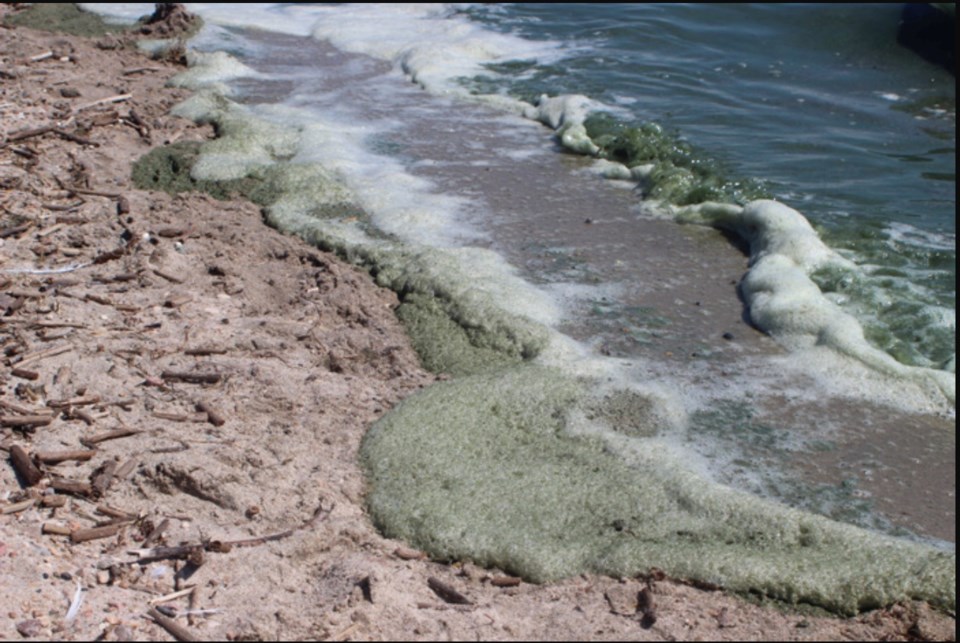LAC LA BICHE - A recent presentation to Lac La Biche County council by Dr. Dörte Köster, Ph.D., a senior aquatic scientist with Associated Environmental says there are a number of factors clouding the waters when it comes to the blue-green algae outbreaks in the Lakeland region. Left un-checked it could spell the ecological death of Alberta's lakes.
For most years in the last decade, provincial health officials have issued alerts and warnings for blue-green algae outbreaks in Lac La Biche lake and other local water bodies. While the algae can cause some health concerns for humans, it can kill animals, and colours the waters with a sheen of oily, unattractive colour.
RELATED: BLUE GREEN ALGAE ALERTS ECPECTED IN SUMMER MONTHS
Lac La Biche County is one of many municipalities across the province affected by the health of local water bodies for environmental and economical reasons. Primary sources of drinking water and main attractions for tourism, the water bodies in the Lakeland region are a under near-constant evaluation.
As recently as last December, Lac La Biche County councillors were directing their administration to bring forward options for nutrient harvesting on Lac La Biche Lake. Nutrient harvesting is a form of in-lake management for water bodies with high nutrient concentrations, which eventually lead to algae blooms. Lac La Biche lake has long been a nutrient-rich location, recording higher than average phosphorus and nitrate numbers. Phosphorus pollution is a leading cause of the nutrient build-ups that form algae-outbreaks. Source points for phosphates coming into the lake are at natural intakes, run-off near residential or agricultural lands, industrial areas, as well as naturally-occurring instances like fecal matter from wildlife and the decay of plant and animal life. Phosphorus and Nitrogen reduction through local waste-water collection legislation at rural developments, environmental guidelines for construction around lakes, and strict monitoring of water quality have been part of the local discussion for decades.
That discussion most recently drew the interest and expertise of Dr. Koster. She made a virtual presentation to council this past Thursday. The information wasn't quite what council was hoping for, however, as many of her answers, research and future options didn't relate to large water bodies like Lac La Biche Lake. She also said her organization had done little lobbying to higher levels of government for funding or larger-scale research. The ill-fitted presentation left council stuck in the weeds, said councillor George L'Heureux.
“The information was outdated. The slides were dated from 1997,” he told the Post, but added that at least the information keeps the discussions open on water quality in the region, and will hopefully lead to a renewed push for more updated and community-specific research. “I just feel we should keep up with science, and keep up to date because things change in the scientific world."
One of those updates, argued the councillor came as Köster explained to council how the blooms can be triggered by sewage, septic fields and runoff from manure spread by livestock operations.
A farmer himself, and a participant in recent studies on the same topic, L'Heureux said new methods, infrastructure and technology at most farm-based operations have reduced chances of high-nutrient animal wastes getting to local water systems.
“Manure spreading is done in spots throughout the province, but not here in Lac La Biche County,” L’Heureux said, adding that "precision" fertilizer spreading and engineered containment infrastructure is in effect at most main feedlots to avoid any seepage.
Köster congratulated those who use "best practices" but said it will take "everyone using the same approach" to have an effect.
“Lac La Biche is not alone with this problem,” she said. “It appears to be a growing problem and a lot of science has been conducted to understand algae growth in our lakes.”
Difficult topic
Warmer weather, lake volume reductions and urban sprawl all continue to be factors, says Koster, also mentioning that more focus from governments around the world has been happening — but slowly. She says there are no easy answers when it comes to the algae issue, no matter if it is in a small pond, a large lake like Lac La Biche or Cold Lake, or one of the Great Lakes. She hopes the continued discussions will help to create avenues towards solutions.
"There is no golden bullet," she said. "An answer — it's really hard to find, and everyone is struggling to address the algae bloom problem"
Lac La Biche County Mayor Omer Moghrabi said the community's namesake lake is the reason that generations have called this region home. Lac La Biche lake and other area water bodies have helped to fuel the region for centuries. He said the water, its history and its future need to be treasured and protected
“Our County has about 60 bodies of water in it, “ Mayor Moghrabi said. “For thousands of years Lac La Biche has been a water-way for our indigenous people.”
While the presentation didn't fit specifically to the options and issues facing the local lake, it did give councillors more background to take concerns to provincial officials.
"One of our biggest hurdles is with the government," said councillor Colin Cote, an active member of healthy water committees in the region.
He hopes to use local committees and local political pressures to explore ne funding options on the issue.
Fort McMurray-Lac La Biche MLA Laila Goodridge was contacted by the POST for comment, but hadn't responded by the editorial deadline.
Any updates on this story can be found at www.lakelandtoday.ca



